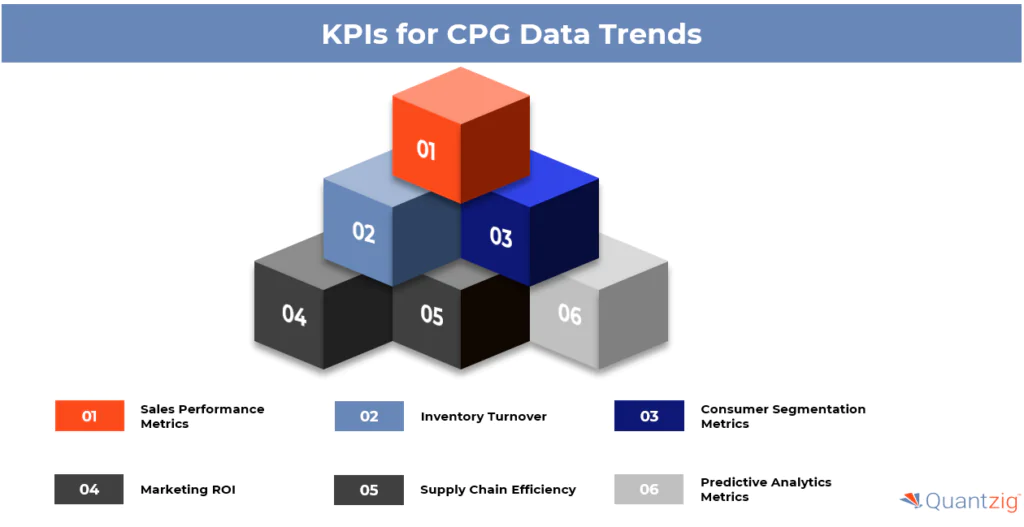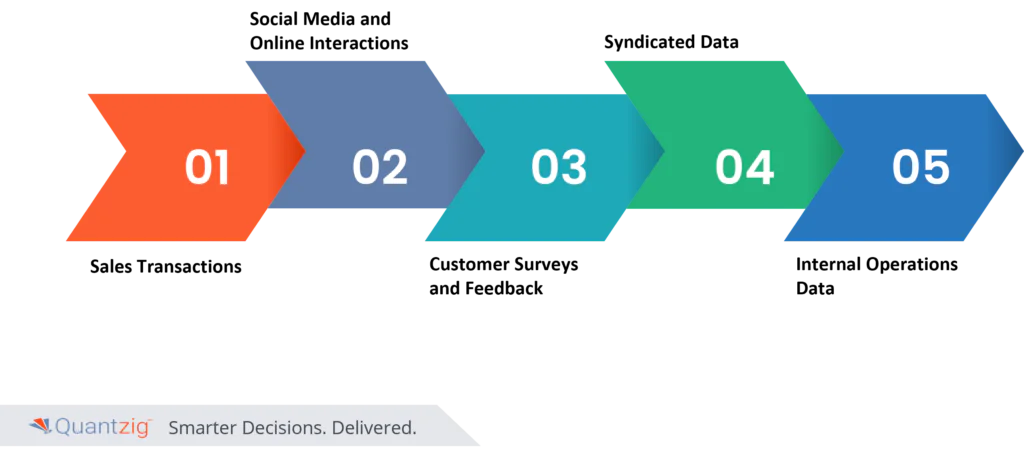Author: Associate Vice President, Analytics and Data Strategy, Quantzig.
Table of Contents
Table of Contents
- Introduction
- What are CPG Data Analytics?
- Key Metrics and KPIs for CPG Data
- How to Collect and Manage CPG Data
- CPG Data Analytics Tools and Software
- Charting the Future of CPG with Quantzig’s Expertise
- Conclusion
Introduction to cPG data analytics
CPG (Consumer Packaged Goods) data analytics has become a critical tool for businesses looking to stay competitive and drive growth. However, CPG brands face unique challenges in accessing valuable purchase data, as their products are primarily sold through retailers rather than directly to consumers. Despite this data gap, CPG data analytics hold immense strategic value. By analyzing sales data, consumer demographics, and feedback, CPG marketers can gain deep understanding of consumer behavior, preferences, and market trends.
In this article, we’ll explore CPG data analytics, including how to interpret them effectively and their importance in driving business outcomes. We’ll also discuss strategies to overcome the data gap, emphasizing the need for digital transformation and a robust data strategy. By bridging this gap, CPG brands can harness data to fuel their success.
Book a demo to experience the meaningful insights we derive from data through our CPG data analytics tools and platform capabilities. Schedule a demo today!
Request a Free DemoWhat are CPG Data Analytics?
CPG (Consumer Packaged Goods) data analytics refers to the process of collecting, analyzing, and leveraging data related to CPG products, customers, and the broader market. It provides valuable insights to help CPG companies make informed decisions across various aspects of their business, from product development and marketing to supply chain optimization and sales strategy.
Key Metrics and KPIs for CPG Data
Understanding the right metrics and KPIs is crucial for maximizing the effectiveness of data trends and analytics. These metrics and KPIs serve as the dashboard for businesses to gauge their performance, understand market dynamics, and make informed decisions.

| Metric | Description |
|---|---|
| Sales Performance | – Sales volume – Sales frequency – Sales value – Assess market position – Understand sales trends – Identify growth opportunities |
| Inventory Turnover | – Inventory turnover rates – Measure efficiency of stock management – High turnover indicates strong sales – Low turnover signals overstocking or declining demand |
| Consumer Segmentation | – Purchase history – Consumer preferences – Demographic data – Tailor products and marketing to specific customer groups |
| Marketing ROI | – Effectiveness of marketing channels and strategies – Analyze impact on sales and customer engagement – Optimize marketing investments |
| Supply Chain Efficiency | – Delivery times – Transportation costs – Supplier reliability – Optimize distribution process |
| Predictive Analytics | – Predictive sales forecasting – Demand planning indicators – Anticipate market changes – Adjust strategies proactively |
By tracking and analyzing these key metrics, CPG companies can gain valuable insights into their business performance, consumer behavior, and market trends. This data-driven approach enables them to make informed decisions, optimize operations, and drive growth in a competitive market.
Experience the advantages firsthand by testing a customized complimentary pilot designed to address your specific requirements. Pilot studies are non-committal in nature.
Request a Free PilotHow to Collect and Manage CPG Data
Effective CPG data analytics hinges on the ability to collect and manage data efficiently. In the consumer goods industry, data comes from a myriad of sources, each offering valuable insights into different aspects of the business.

Data Collection:
- Sales Transactions: Aggregate and analyze sales data to uncover insights into performance, preferences, and trends
- Social Media and Online Interactions: Analyze consumer sentiment, trends, and brand perception from digital interactions
- Customer Surveys and Feedback: Gather direct consumer feedback to understand needs and expectations
- Syndicated Data: Purchase external market and competitive data to inform strategic planning
- Internal Operations Data: Leverage data from supply chain, inventory, and other internal processes
Data Management:
- Ensure Data Quality: Implement processes to maintain data integrity and accuracy
- Integrate Data Sources: Combine data from various internal and external sources for a comprehensive view
- Employ Analytics Tools: Utilize CPG-specific analytics software for seamless data integration, visualization, and analysis
- Leverage Data Transformation: Use data transformation tools to prepare data for effective analysis
- Implement Enterprise Systems: Adopt robust enterprise systems to streamline data management
Strategic Considerations:
- Adopt Agile Strategies: Leverage technology and data-driven cpg data insights to adapt to market changes
- Optimize Technology Budgets: Invest in the right tools and platforms to enhance data management and analytics capabilities
- Incorporate AI-Driven Insights: Leverage AI and machine learning to uncover deeper, more actionable cpg data insights
- Embrace Virtual Shopping: Analyze data from virtual shopping experiences to understand evolving consumer behavior
- Align with R&D Initiatives: Utilize data to inform product development and innovation efforts
By effectively collecting, managing, and strategically leveraging CPG data, companies can gain a comprehensive understanding of their market, optimize operations, and stay competitive in the rapidly evolving consumer-packaged goods industry.
Also read: Low-Code Automated Material Tracking System for Manufacturing Efficiency
What are the CPG Data Analytics Tools and Software?

- Retailer Portals: CPG brands can access data through retailer portals, which is often the easiest way to get started with data analytics as it doesn’t require additional software or hardware.
- Syndicated Data Tools: These include panel data and retail data tools from market research companies that provide aggregated sales and consumer insights to compare product performance against the industry.
- Predictive Analytics Tools: Solutions that leverage advanced analytics, machine learning, and simulation to anticipate market trends, optimize inventory and supply chain, and enable data-driven decision-making.
- Visualization and Reporting Tools: Tools that facilitate data visualization, collaboration, and informed decision-making, such as dashboards and reporting capabilities.
- Data Integration and Management Platforms: Solutions that enable the consolidation of data from various sources, including retailers, distributors, and e-commerce channels, into a centralized, integrated platform for analysis.
- Data Quality Management Tools: Platforms that help identify, rectify, and prevent data quality issues throughout the data lifecycle, ensuring the reliability of CPG data insights.
- Cloud-based Analytics Platforms: Tools that leverage cloud computing to provide scalable, flexible, and cost-effective data processing and analytics capabilities for CPG companies.
- Multi-Touch Attribution Tools: Solutions that help CPG marketers measure the impact of different marketing touchpoints on sales, enabling in-flight campaign optimization and data-driven decision-making.
- Natural Language Processing (NLP) Tools: Platforms that allow users to retrieve information from various sources, such as documents and audio/video, through natural language conversations, facilitating quick access to relevant data.
- Revenue Growth Management Tools: Solutions that help CPG companies optimize their pricing, assortment, and distribution strategies to drive sustainable revenue growth.
These tools and software solutions enable CPG companies to collect, integrate, analyze, and leverage data to make informed decisions, optimize operations, and stay competitive in the rapidly evolving consumer goods market.
Charting the Future of CPG with Quantzig’s Expertise

Quantzig’s Expertise in CPG Data Analytics
- Deep domain knowledge of the CPG industry landscape
- Extensive experience in leveraging data analytics to drive business results for CPG companies
- Ability to transform observational data into a strategic asset for CPG organizations
Quantzig’s Tailored Analytics Solutions for CPG
- Enhancing supply chain efficiency through data-driven insights
- Refining pricing strategies to optimize profitability
- Unlocking new market opportunities through advanced customer segmentation
- Leveraging predictive analytics to anticipate market trends and shifts
Quantzig’s Approach as a Strategic Partner
- Commitment to driving tangible business results for CPG clients
- Utilization of state-of-the-art tools and advanced analytics techniques
- Leveraging deep industry-specific expertise to help navigate market complexities
- Empowering CPG companies to emerge as market leaders
Key Benefits for CPG Clients
- Transforming data into a strategic competitive advantage
- Optimizing operations and enhancing overall profitability
- Identifying new growth opportunities within the market
- Staying ahead of evolving market trends and competition
By partnering with Quantzig, CPG companies can harness the power of data analytics to chart a successful future in the ever-evolving consumer goods market. Quantzig’s holistic approach and deep industry expertise enable clients to make informed, data-driven decisions and achieve sustainable growth.
Get started with your complimentary trial today and delve into our platform without any obligations. Explore our wide range of customized, consumption driven analytical solutions services built across the analytical maturity levels.
Start your Free TrialConclusion
In conclusion, mastering CPG data analytics is essential for manufacturers to stay competitive and achieve success in today’s dynamic market. By leveraging advanced data analytics strategies, business intelligence, and machine learning capabilities, manufacturers can gain deep insights into consumer behavior and preferences. Utilizing platforms like Snowflake and Google Cloud Platform (GCP), along with integrating CRM data, data lakes, and Internet of Things data, enhances decision-making and operational efficiency. Embracing these trends and technologies enables manufacturers to drive innovation, optimize product offerings, and ultimately thrive in the evolving landscape of CPG.

![[Webinar] Developing Low-Code Automation and Data Roadmap](https://www.quantzig.com/wp-content/webp-express/webp-images/uploads/2024/02/Webinar-Banner-6.png.webp)
![[Event] PMSA 2024 Global Summit – The Evolution Of Data, Analytics & AI](https://www.quantzig.com/wp-content/webp-express/webp-images/uploads/2024/03/Webinar-Banner-1.png.webp)
![[Webinar] Embedding Digital Twins and Process Engineering in Business Processes](https://www.quantzig.com/wp-content/webp-express/webp-images/uploads/2024/03/vijay-ganesan.jpg.webp)